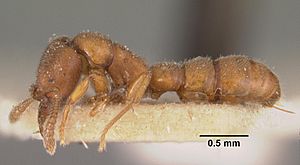Fulakora saundersi facts for kids
Quick facts for kids Fulakora saundersi |
|
|---|---|
 |
|
| Fulakora saundersi worker | |
| Scientific classification | |
| Kingdom: | |
| Phylum: | |
| Class: | |
| Order: | |
| Family: | |
| Subfamily: |
Amblyoponinae
|
| Tribe: |
Amblyoponini
|
| Genus: |
Fulakora
|
| Species: |
F. saundersi
|
| Binomial name | |
| Fulakora saundersi (Forel, 1892)
|
|
| Synonyms | |
|
Amblyopone saundersi Forel, 1892 Stigmatomma saundersi (Forel, 1892) |
|
The Fulakora saundersi is a special type of ant found only in New Zealand. People often call it "The New Zealand Michelin Ant." It belongs to the ant family called Formicidae. This ant was first described by Forel in 1892.
Contents
About the New Zealand Michelin Ant
The New Zealand Michelin ant is a small insect. Worker ants are usually about 3 to 5 millimeters long. That's about the size of a few grains of rice!
What it Looks Like
This ant has a dark brown head and middle body part (called the thorax). Its back part (the abdomen) starts brown and gets lighter. All six of its legs are light brown.
The Michelin ant has two short antennae with 12 segments each. It also has eight teeth on its mouthparts (called mandibles). These teeth help it grab and eat food. It has small eyes on the sides of its head.
Fulakora saundersi is smaller and thinner than a similar ant, Amblyopone australis.
Where it Lives
Its Home in New Zealand
The Fulakora saundersi ant is found only in New Zealand. This means it is endemic to the country. It lives all over the three main islands: Stewart Island, South Island, and North Island. You can also find it on smaller islands like the Chatham Islands and Three Kings Island.
Where it Builds Nests
These ants live in different places across New Zealand. They like forests, coastal areas with bushes, and even gardens. They build their nests under piles of leaves or inside rotting logs and branches. They usually stay underground and don't come out much during the day.
How it Lives
Life Cycle of the Michelin Ant
Like many ants, the New Zealand Michelin ant usually has one breeding time each year. During this time, male and female ants with wings fly out of their nests. They mate in the air. After mating, the males die. The females then land and sometimes eat the wings of the dead males.
After mating, the female ants fly off to start a new colony. This way of starting a new home is called colony budding. Scientists don't know all the details about this ant's exact life cycle. However, it's thought to be similar to other ants. The queen ant lays eggs. Fertilized eggs become female ants, and unfertilized eggs become male ants.
The whole life cycle, from egg to adult, takes about 6 to 10 weeks. These ant colonies are quite small, usually having only 10 to 30 worker ants. Their nests are simple, shallow tunnels in the soil. They are temporary homes, lasting only a few generations of workers.
What it Eats and How it Finds Food
Fulakora saundersi ants are carnivores, which means they eat other insects. Worker ants have been seen feeding small pieces of insects to their young (larvae). This is a basic way of feeding, unlike the more advanced method called trophallaxis, where ants share food by mouth.
If there isn't enough food, the ant larvae might even eat each other! The queen ant will also look for food for her first group of larvae. She might continue to help the workers find food later on. The larvae and queen often eat special "trophic eggs" as a food source.
Worker ants can sting their prey to make them stop moving. They then grab the prey with their mandibles and inject a strong toxin.
Who Eats the Michelin Ant
Many native animals in New Zealand can be predators of the Michelin ant. These include birds, beetles, and snails. Other types of ants that have been brought to New Zealand, like the Argentine ant, can also be a threat. The Argentine ant was first seen in New Zealand in 1990.
Related Species
The Fulakora saundersi ant is unique to New Zealand. However, it is related to a group of ants called Amblyopone. There are 62 known species in the Amblyopone group, and 17 of them live in Australia.
The New Zealand Michelin ant has some special features that make it different. For example, it's smaller than its relative Amblyopone australis. It also has some "primitive" features, like not using trophallaxis to share food. This might mean that its ancestors separated from other ants a very long time ago.
How Scientists Study Them
Scientists often find and study Fulakora saundersi ants using special traps. These are called pitfall traps. They also collect samples of leaf litter from forests and scrublands to find the ants living there.
See also
 In Spanish: Fulakora saundersi para niños
In Spanish: Fulakora saundersi para niños

